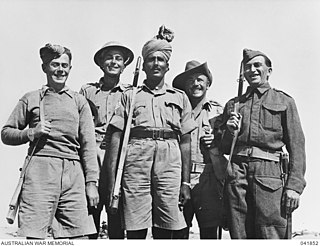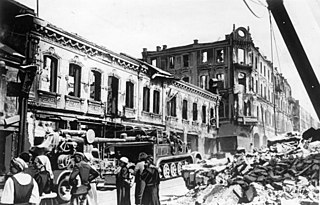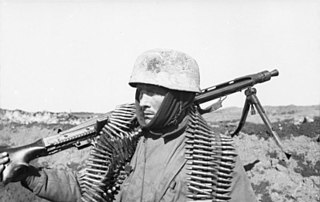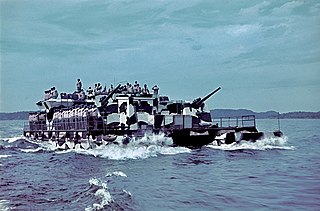Related Research Articles

The Workers' and Peasants' Red Army, often shortened to the Red Army, was the army and air force of the Bolshevik Party, Russian Soviet Federative Socialist Republic and, after 1922, the Union of Soviet Socialist Republics. The army was established in January 1918. The Bolsheviks raised an army to oppose the military confederations of their adversaries during the Russian Civil War. Starting in February 1946, the Red Army, along with the Soviet Navy, embodied the main component of the Soviet Armed Forces, taking the official name of "Soviet Army", until its dissolution in 1991.

World War II was the deadliest military conflict in history. An estimated total of 70–85 million people perished, or about 3% of the 2.3 billion (est.) people on Earth in 1940. Deaths directly caused by the war are estimated at 50–56 million, with an additional estimated 19–28 million deaths from war-related disease and famine. Civilian deaths totaled 50–55 million. Military deaths from all causes totaled 21–25 million, including deaths in captivity of about 5 million prisoners of war. More than half of the total number of casualties are accounted for by the dead of the Republic of China and of the Soviet Union. The tables below give a detailed country-by-country count of human losses. Statistics on the number of military wounded are included whenever available.

The Battles of Khalkhin Gol were the decisive engagements of the undeclared Soviet–Japanese border conflicts involving the Soviet Union, Mongolia, Japan and Manchukuo in 1939. The conflict was named after the river Khalkhin Gol, which passes through the battlefield. In Japan, the decisive battle of the conflict is known as the Nomonhan Incident after Nomonhan, a nearby village on the border between Mongolia and Manchuria. The battles resulted in the defeat of the Japanese Sixth Army.

The Invasion of Poland, also known as the September Campaign, Polish Campaign, War of Poland of 1939, and Polish Defensive War of 1939, was a joint attack on the Republic of Poland by Nazi Germany, the Slovak Republic, and the Soviet Union; which marked the beginning of World War II. The German invasion began on 1 September 1939, one week after the signing of the Molotov–Ribbentrop Pact between Germany and the Soviet Union, and one day after the Supreme Soviet of the Soviet Union had approved the pact. The Soviets invaded Poland on 17 September. The campaign ended on 6 October with Germany and the Soviet Union dividing and annexing the whole of Poland under the terms of the German–Soviet Frontier Treaty. The invasion is also known in Poland as the September campaign or 1939 defensive war and known in Germany as the Poland campaign.

The European theatre of World War II was one of the two main theatres of combat during World War II. It saw heavy fighting across Europe for almost six years, starting with Germany's invasion of Poland on 1 September 1939 and ending with the Western Allies conquering most of Western Europe, the Soviet Union conquering most of Eastern Europe including the German capital Berlin, and Germany's unconditional surrender on 8 May 1945 although fighting continued elsewhere in Europe until 25 May. On 5 June 1945, the Berlin Declaration proclaiming the unconditional surrender of Germany to the four victorious powers was signed. The Allied powers fought the Axis powers on two major fronts, but there were other fronts varying in scale from the Italian campaign, to the Polish Campaign, as well as in a strategic bombing offensive and in the adjoining Mediterranean and Middle East theatre.

The Eastern Front of World War II was a theatre of conflict between the European Axis powers against the Soviet Union (USSR), Poland and other Allies, which encompassed Central Europe, Eastern Europe, Northeast Europe (Baltics), and Southeast Europe (Balkans) from 22 June 1941 to 9 May 1945. Of the estimated 70–85 million deaths attributed to World War II, around 30 million occurred on the Eastern Front, including 9 million children. The Eastern Front was decisive in determining the outcome in the European theatre of operations in World War II, eventually serving as the main reason for the defeat of Nazi Germany and the Axis nations.

The Western Front was a military theatre of World War II encompassing Denmark, Norway, Luxembourg, Belgium, the Netherlands, the United Kingdom, France, and Germany. The Italian front is considered a separate but related theatre. The Western Front's 1944–1945 phase was officially deemed the European Theater by the United States, whereas Italy fell under the Mediterranean Theater along with North Africa. The Western Front was marked by two phases of large-scale combat operations. The first phase saw the capitulation of Luxembourg, Netherlands, Belgium, and France during May and June 1940 after their defeat in the Low Countries and the northern half of France, and continued into an air war between Germany and Britain that climaxed with the Battle of Britain. The second phase consisted of large-scale ground combat, which began in June 1944 with the Allied landings in Normandy and continued until the defeat of Germany in May 1945.

The siege of Tobruk took place between April 10 and November 27, 1941, when elements of the Allied Army were trapped and besiged in the North African port of Tobruk by German and Italian forces. The defenders quickly became known as the Rats of Tobruk.

Operation Brevity was a limited offensive conducted in mid-May 1941, during the Western Desert Campaign of the Second World War. Conceived by the commander-in-chief of the British Middle East Command, General Archibald Wavell, Brevity was intended to be a rapid blow against weak Axis front-line forces in the Sollum–Capuzzo–Bardia area of the border between Egypt and Libya. Although the operation got off to a promising start, throwing the Axis high command into confusion, most of its early gains were lost to local counter-attacks, and with German reinforcements being rushed to the front the operation was called off after one day.

The Battle of Cassano was fought in 1799 from 27 to 28 April near Cassano d'Adda, which about 28 km (17 mi) ENE of Milan. The clash is part of the battle of the Adda River or the so-called forcing of the Adda, which on the first day of 26 April resulted in a minor victory for the Russians under the Count Suvorov over Barthélemy Schérer's French forces at Lecco. Then, on the second day, Suvorov's Austrians and Cossacks prevailed over Jean Moreau's army, who replaced Schérer as supreme commander, and trapped his isolated division on the third. The action took place during the War of the Second Coalition, as part of the larger conflict known as the French Revolutionary Wars.

The Italian participation on the Eastern Front represented the military intervention of the Kingdom of Italy in the Operation Barbarossa, launched by Nazi Germany against the Soviet Union in 1941. The commitment to actively take part in the German offensive was decided by Benito Mussolini a few months before the beginning of the operation, when he became aware of Adolf Hitler's intention to invade, but it was confirmed only in the morning of 22 June 1941, as soon as the Italian dictator was informed that same day the German armies had given way to the invasion.

The Battle of Białystok–Minsk was a German strategic operation conducted by the Wehrmacht's Army Group Centre under Field Marshal Fedor von Bock during the penetration of the Soviet border region in the opening stage of Operation Barbarossa, lasting from 22 June to 9 July 1941.

The Battle of the Kerch Peninsula, which commenced with the Soviet Kerch-Feodosia Landing Operation and ended with the German Operation Bustard Hunt, was a World War II battle between Erich von Manstein's German and Romanian 11th Army and the Soviet Crimean Front forces in the Kerch Peninsula, in the eastern part of the Crimean Peninsula. It began on 26 December 1941, with an amphibious landing operation by two Soviet armies intended to break the Siege of Sevastopol. Axis forces first contained the Soviet beachhead throughout the winter and interdicted its naval supply lines through aerial bombing. From January through April, the Crimean Front launched repeated offensives against the 11th Army, all of which failed with heavy losses. The Red Army lost 352,000 men in the attacks, while the Axis suffered 24,120 casualties. Superior German artillery firepower was largely responsible for the Soviet debacle.

The 27th Infantry Division "Brescia" was an infantry division of the Royal Italian Army during World War II. The Brescia was named after the city of Brescia in Lombardy. The Brescia was classified as an auto-transportable division, meaning it had some motorized transport, but not enough to move the entire division at once.

Horses in World War II were used by the belligerent nations, for transportation of troops, artillery, materiel, messages, and, to a lesser extent, in mobile cavalry troops. The role of horses for each nation depended on its military doctrines, strategy, and state of economy. It was most pronounced in the German and Soviet Armies. Over the course of the war, Germany and the Soviet Union together employed more than six million horses.

Statistics for German World War II military casualties are divergent. The wartime military casualty figures compiled by German High Command, up until January 31, 1945, are often cited by military historians when covering individual campaigns in the war. A study by German historian Rüdiger Overmans found that the German military casualties were 5.3 million, including 900,000 men conscripted from outside of Germany's 1937 borders, in Austria and in east-central Europe, higher than those originally reported by the German high command. The German government reported that its records list 4.3 million dead and missing military personnel.

The Battle of Tali–Ihantala was part of the Finnish-Soviet Continuation War (1941–1944), which occurred during World War II. The battle was fought between Finnish forces—using war materiel provided by Germany—and Soviet forces. To date, it is the largest battle in the history of the Nordic countries.

The Fallschirmjäger were the paratrooper branch of the German Luftwaffe before and during World War II. They were the first paratroopers to be committed in large-scale airborne operations. Throughout World War II, the commander of the branch was Kurt Student.

The Battle of Sukho Island, also known as Operation Brazil, was an amphibious operation and naval engagement on Lake Ladoga between the Soviet Navy and a German Luftwaffe naval detachment during World War II.

The Western Allied Campaign in Romania consisted of war declarations and aerial operations during the Second World War by eight Western Allied countries against Romania which itself was primarily engaged on the Eastern Front in fighting against the Soviet Union.
References
- 1 2 3 4 5 6 7 8 9 10 11 12 13 14 15 16 17 18 19 20 21 22 23 Clodfelter, Micheal (2002). Warfare and Armed Conflicts- A Statistical Reference to Casualty and Other Figures, 1500-2000 2nEd. ISBN 0-7864-1204-6.
- ↑ Panecki, T. Wsiłek zbrojny Polski w II wojnie światowej pl:Wojskowy Przegląd Historyczny, 1995, no. 1-2.
- 1 2 Overmans, Rüdiger (2000). deutsche militärische Verluste im Zweiten Weltkrieg. Oldenbourg. ISBN 3-486-56531-1.
- ↑ Krivosheev, G. I. (1997). Soviet Casualties and Combat Losses. Greenhill. ISBN 1-85367-280-7.
- ↑ Zaloga, Steven (1985). The Polish Campaign. ISBN 0-88254-994-4.
- ↑ Clodfelter, Micheal (2002). Warfare and Armed Conflicts- A Statistical Reference to Casualty and Other Figures, 1500-2000 2nEd. p. 484. ISBN 0-7864-1204-6.
- 1 2 3 Ellis, John (1993). World War II - A statistical survey. Facts on File. ISBN 0-8160-2971-7.
- ↑ Clodfelter, Micheal (2002). Warfare and Armed Conflicts- A Statistical Reference to Casualty and Other Figures, 1500-2000 2nEd. p. 486. ISBN 0-7864-1204-6.
- ↑ La prima offensiva britannica in Africa settentrionale (ottobre 1940 – febbraio 1941) [The First British Offensive in North Africa (October 1940 – February 1941)] (in Italian), I, annex 32, Rome: Esercito. Corpo di stato maggiore. Ufficio storico., p. 374.
- ↑ La prima offensiva britannica in Africa settentrionale (ottobre 1940 – febbraio 1941) [The First British Offensive in North Africa (October 1940 – February 1941)] (in Italian), I, annex 32, Rome: Esercito. Corpo di stato maggiore. Ufficio storico., p. 179
- ↑ La prima offensiva britannica in Africa settentrionale (ottobre 1940 – febbraio 1941) [The First British Offensive in North Africa (October 1940 – February 1941)] (in Italian), I, annex 32, Rome: Esercito. Corpo di stato maggiore. Ufficio storico., p. 376
- ↑ Young, Peter (1977). Dictionary of Battles (1816-1976) . New York: Mayflower Books. ISBN 0-8317-2260-6.
- 1 2 G.F.Krivosheev (1997). Soviet casualties and combat losses in the twentieth century. London: Greenhill Books.
- ↑ David, Glantz (1995). When Titans Clashed. Univ. of Kansas Press. ISBN 0-7006-0717-X.
- ↑ 1st Czechoslovak army corps (1944-1945) Archived 2008-08-02 at the Wayback Machine Czechpatriots.com
- ↑ Steven J Zaloga (1982). "The Polish People's Army". Polish Army, 1939-1945. Oxford: Osprey Publishing. ISBN 0-85045-417-4.[ permanent dead link ]
- ↑ Polish Armed Forces in WWII Polishembassy.ca
- ↑ Romulus Dima, Contribuţia României la înfrângerea Germaniei fasciste (Contribution of Romania to the German offensive. In Romanian). Bucharest, 1982
- ↑ Dimitrov, Božidar (1994). "Bulgaria during World War II". Bulgaria: illustrated history. Sofia: Borina. ISBN 954-500-044-9. Archived from the original on 2007-02-03. Retrieved 2009-01-13.
- ↑ Seppo Myllyniemi (1982). Suomi sodassa, 1939-1945 (Finland in War, 1939-1945. In Finnish). Otava, Helsinki
- ↑ Karel Bartošek, Pražské povstání 1945 (Prague Uprising, 1945. In Czech), 1965
- ↑ G.F. Krivosheev, ‘Soviet Casualties and Combat Losses in the twentieth century’
- ↑ Pacner, K. Osudove okamziky Ceskoslovenska (Decisive Moments of Czechoslovakia; in Czech), p.270
- 1 2 Pacner, p.270
- ↑ Armia Krajowa Archived 2016-08-26 at the Wayback Machine Encyclopaedia Wiem. Last accessed on 2 April 2008
- 1 2 Erlikman, pp.38-39
- ↑ Mark Axworthy. Third Axis Fourth Ally, pp.216-217
- ↑ "Jatkosodan historia (History of Continuation War, in Finnish) vol. 6
- Clodfelter, Micheal (2002). Warfare and Armed Conflicts- A Statistical Reference to Casualty and Other Figures, 1500-2000 2nd Ed. ISBN 0-7864-1204-6.
- Eggenberger, David (1985). An Encyclopedia of Battles. New York: Dover Books. ISBN 0-486-24913-1.
- Ellis, John (1993). World War II - A statistical survey. Facts on File. ISBN 0-8160-2971-7.
- David, Glantz (1995). When Titans Clashed. Univ. of Kansas Press. ISBN 0-7006-0717-X.
- Krivosheev, G. I. (1997). Soviet Casualties and Combat Losses. Greenhill. ISBN 1-85367-280-7.
- Overmans, Rüdiger (2000). Deutsche militärische Verluste im Zweiten Weltkrieg. Oldenbourg. ISBN 3-486-56531-1.
- Panecki, T. Wsiłek zbrojny Polski w II wojnie światowej pl:Wojskowy Przegląd Historyczny, 1995, no. 1-2.
- Piotrowski, Tadeusz (1998). Poland's Holocaust. McFarland. ISBN 0-7864-0371-3.
- Young, Peter (1977). Dictionary of Battles (1816-1976) . New York: Mayflower Books. ISBN 0-8317-2260-6.
- Zaloga, Steven (1985). The Polish Campaign. ISBN 0-88254-994-4.